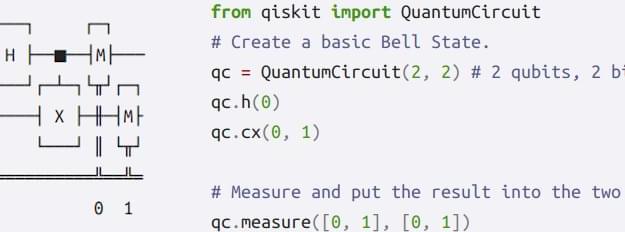The robot takeover starts at the drive thru as fast food rapidly turns to automation.
Historically, the first program you write for a new computer language is “Hello World,” or, if you are in Texas, “Howdy World.” But with quantum computing on the horizon, you need something better. Like “Hello Many Worlds.” [IonQ] proposes what that looks like and then writes it in seven different quantum languages in a post you should check out.
Here’s the description of the simple program:
The basic quantum program we’ll write is simple. It creates a fully-entangled state between two qubits, and then measures this state. This state is sometimes called a Bell State, or Bell Pair, after physicist John Stewart Bell.
The omicron wave that assaulted the United States this winter also bolstered its defenses, leaving enough protection against the coronavirus that future spikes will likely require much less — if any — dramatic disruption to society.
Millions of individual Americans’ immune systems now recognize the virus and are primed to fight it off if they encounter omicron, or even another variant.
About half of eligible Americans have received booster shots, there have been nearly 80 million confirmed infections overall and many more infections have never been reported. One influential model uses those factors and others to estimate that 73% of Americans are, for now, immune to omicron, the dominant variant, and that could rise to 80% by mid-March.
The images show that Ukraine is surrounded on three sides by Russian hardware and troops.
Within the human brain, neurons perform complex calculations on information they receive. Researchers at MIT have now demonstrated how dendrites—branch-like extensions that protrude from neurons—help to perform those computations.
The researchers found that within a single neuron, different types of dendrites receive input from distinct parts of the brain, and process it in different ways. These differences may help neurons to integrate a variety of inputs and generate an appropriate response, the researchers say.
In the neurons that the researchers examined in this study, it appears that this dendritic processing helps cells to take in visual information and combine it with motor feedback, in a circuit that is involved in navigation and planning movement.
In a paper published by Science, DeepMind demonstrates how neural networks can improve approximation of the Density Functional (a method used to describe electron interactions in chemical systems). This illustrates deep learning’s promise in accurately simulating matter at the quantum mechanical.
In a paper published in the scientific journal Science, DeepMind demonstrates how neural networks can be used to describe electron interactions in chemical systems more accurately than existing methods.
Density Functional Theory, established in the 1960s, describes the mapping between electron density and interaction energy. For more than 50 years, the exact nature of mapping between electron density and interaction energy — the so-called density functional — has remained unknown. In a significant advancement for the field, DeepMind has shown that neural networks can be used to build a more accurate map of the density and interaction between electrons than was previously attainable.
By expressing the functional as a neural network and incorporating exact properties into the training data, DeepMind was able to train the model to learn functionals free from two important systematic errors — the delocalization error and spin symmetry breaking — resulting in a better description of a broad class of chemical reactions.
While it’s difficult to put something as vast, conceptual, and, frankly still emerging as the metaverse in quantifiable terms, Jon Radoff breaks it down logically and thoroughly.
When it comes to describing the metaverse, definitions and opinions abound. And while it’s difficult to put something as vast, conceptual, and, frankly, still emerging as the metaverse into quantifiable terms, Jon Radoff, entrepreneur, author and game designer, breaks it down logically and thoroughly in Measuring the Metaverse. He moves up the value chain from infrastructure at the bottom to experience at the top, stopping at human interface, decentralization, spatial computing, creator economy, and discovery along the way.
A common framework is necessary in Radoff’s view of the metaverse. He writes, “And while there will be many proprietary (and very fun) theme parks in the metaverse, I’m even more excited by the opportunity in the Switzerlands: a metaverse powered by a robust creator-economy enabled through decentralization.”
This, of course, isn’t the first seven-layer model to lay out a critical framework. The IT world has long adhered to the seven layers of the OSI Model to organize networking functions into a universal set of rules and requirements to support interoperability among different products and software. Perhaps Radoff’s seven-layer model will become a similar conceptual framework for the metaverse.
Before the pandemic started (ah, those glorious days…) a collective panic was mounting over automation and robots gradually replacing workers in various fields, or “stealing our jobs,” as the common refrain went. These worries haven’t subsided two years later, but they’re being countered by severe and largely unexpected labor shortages across multiple sectors of the economy. One of the industries that’s struggling most is restaurants. While we may still encounter automation-related unemployment problems down the road, right now it seems robots are lending a much-needed hand in food service.
One of these robots is none other than Flippy, initially debuted in 2017 to flip burgers at a California fast food chain. Since then Miso Robotics, Flippy’s maker, has expanded the bot’s capabilities, creating a version that can cook chicken wings, fries, and other greasy delights. This week also brought a significant expansion to Flippy’s presence as White Castle announced plans to install the robot at more than 100 restaurants this year.
White Castle was the first restaurant chain to significantly invest in Flippy, piloting the robotic assistant in 2020. The chain gave feedback about the robot to Miso, and the company put out a second iteration called Flippy 2 last November. This new robot can independently do the work of an entire fry station: its AI-enabled vision identifies foods, picks them up, and cooks them in fry baskets designated for that food specifically. The bot then moves cooked items to a hot-holding area.
Eric Schmidt and co-author Graham Allison said in an op-end that 5G development is key as it could enhance a country’s military and intelligence capabilities.
WASHINGTON, Feb 17 (Reuters) — A single activist helped turn the tide against NSO Group, one of the world’s most sophisticated spyware companies now facing a cascade of legal action and scrutiny in Washington over damaging new allegations that its software was used to hack government officials and dissidents around the world.
It all started with a software glitch on her iPhone.
An unusual error in NSO’s spyware allowed Saudi women’s rights activist Loujain al-Hathloul and privacy researchers to discover a trove of evidence suggesting the Israeli spyware maker had helped hack her iPhone, according to six people involved in the incident. A mysterious fake image file within her phone, mistakenly left behind by the spyware, tipped off security researchers.









